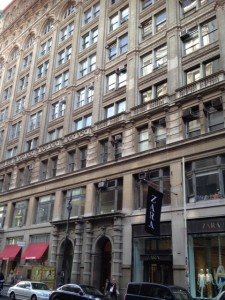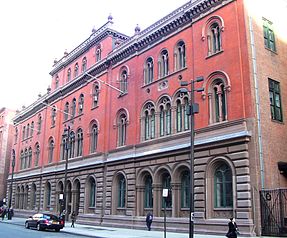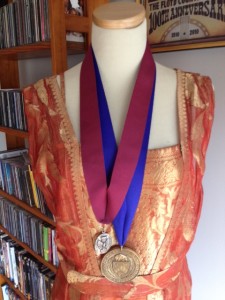
Working on the restoration of the Belvedere Castle in Central Park was one of the highlights of my career as a preservation architect. Does that make me a lesser architect because I’m not designing skyscrapers?
It’s time to talk about ” women architects”. And it’s time for me, someone who has been gainfully employed for 25 years as an architect mostly in leadership positions, to open up about gender inequity in the architectural field. I just finished reading Sheryl Sandberg’s Lean In. And while I was not overly impressed with her (and her writing partner’s) writing skills, I was impressed at her ability to hone in on the problems we all face as professional women, many of which we perpetuate ourselves, sadly.
This is a topic I’ve thought about delving into since my friends and colleagues helped launch Architect Barbie two years ago. But it hasn’t seemed like the right time till now. This month’s Architectural Record is a special issue on Women In Architecture Now and it opened up all kinds of memories and feelings, both good and bad. And I found its main essay a disturbing statement regarding what makes a “successful” architect, woman or man.

My first office, Campagna & Russo Architects, was located in this terrific office loft building at 580 Broadway in New York City, the heart of SoHo. We were on the 5th floor overlooking Broadway.
I would like to start by saying that architecture is the great love of my life. It combines all of the interests I’ve had since I was a child – art, materials, history, math and science. There is almost nothing I do or nowhere I go that isn’t influenced by architecture. I knew when I was 14 that I would be an architect. Five of the greatest moments of my life were singular architecture moments: graduating from architecture school, receiving the letter from Columbia University informing me that I had been accepted to the GSAPP, sitting in my first office in SoHo unpacking our boxes, receiving the Young Architect of the Year Award and walking down the aisle in the San Francisco Cathedral to be inducted as a Fellow in the AIA.
My Mentors Were Mostly Male
I had no real women mentors except for Sister Mary Catherine and my mother, neither of whom were architects. The two watershed moments in my life that set me on my architecture path happened in my sophomore year of high school. I was attending an all-girl private catholic school where I often found myself bored except for art classes. Early sophomore year our art teacher, Sister Mary Catherine, introduced us to perspective. I loved it, continually drawing awful avocado green and orange split-level houses! Sr. Mary Catherine said I was the first student she ever had who enjoyed learning perspective and I should consider becoming an architect. My path was set. I became obsessed with architecture, reading and learning everything I could about it as a field and a career. I became determined to learn mechanical drafting which was no easy task at an all-girl’s school. I signed up for summer classes at the local public school. In the meantime, my parents noticed my new found interest and questioned whether it made sense to take all these classes during the summer. When I was signing up for my junior classes at the end of the year I tried to sign up for both physics and calculus. In order to take physics I would have to miss Junior-level religion. I was sent to the principal’s office, where I was told I had to take religion. For the first time in my life I defied authority and stood my ground. “Why do I need another year of religion which will not help me be an architect?” She called my mother, whom I had not briefed on this at all. My mother surprisingly said, “Let her take physics.” When I came home from school that day, my mom told me she had made an appointment to visit Williamsville East High School (the high school in the new neighborhood we were moving to that summer). Williamsville East was and still is one of the best public schools in the Buffalo area. There I blossomed intellectually, taking multiple art, mechanical drafting, math and calculus classes, and AP classes. My art teachers, Mr. Coniglio and Mr. Keller, went out of their way to let me take classes that were scheduled at the same time. Mr. Keller taught me three mechanical drafting classes in two years and worked with me to design and build the new photography dark room at the school. He also helped me make my portfolio, which got me into architecture school. I am forever indebted to the quiet, intense man who recognized my desire to be an architect.

Low Library at Columbia University represents all I love about studying for my Master’s degree at Columbia.
In architecture school, I had male studio professors almost exclusively, except for one professor, a woman landscape architect, whom I remain close friends with. I consider my architectural history professor my most important college mentor, a man known world-wide as a Frank Lloyd Wright scholar, who instilled in me a love for inquiry and historic buildings. My mentors at Columbia were men, one of the best-known classical architects in the field and another traditionally focused architect who was my studio thesis professor. But neither of those relationships really lasted past graduation. My first professional job was with a grand man, Giorgio Cavaglieri, one of the real founders of the NYC professional preservation movement. He hired me while I was at Columbia because his best friend from Venice was named “Campagna” and he loved my drawings of Richard Meier’s Smith House. His significance in my life lasted well past our working together.
I never observed or worked with other senior or management-level women architects until I had been in the field for 15 years and was in a senior position myself. I guess you might say then that the only models I had as I was molded as an architect myself were men. Were they all equal? Absolutely not. I gravitated to the ones who were kind and intelligent, had well-rounded lives and were supportive of their staff. I stayed as far away as possible from the negative reinforcers. But I, like all the other overachievers, worked long, long hours, missed holidays and still find myself on more planes than I care to count.
You’re Too Friendly With Your Staff

Developing the specifications for cleaning the Federal Reserve Bank of New York was one of the most complex preservation projects I have completed. Photo courtesy the Federal Reserve Bank of NY.
I’ve thought a lot about the differences between the way women and men work. And it was the clearest to me when I was a principal at a large A/E firm in New York City. I was the preservation principal at the new NYC office of a national firm. There were 10 partners in that office, a mixture of architects and engineers. I was the only woman principal architect although there was a woman structural engineering principal. The managing partner of the office was a man who believed that negative reinforcement was the best way to encourage growth, an approach anathema to me. He terrorized the staff and the other principals. I was the only one who stood up to him. My fellow principals would complain behind his back, but ultimately, it always seemed I was the only one who questioned or disagreed with him in our weekly principal meetings. I had developed a core team of about 10 preservation professionals, all of whom loved working together. We enjoyed working and going out together. We went to happy hours and yoga classes together, and all were important parts of each others’ lives. I was told repeatedly by my male partners that I was “too friendly with my staff.” We collaborated at work and after work, which made the work and our lives so much better.
I Consider Myself Lucky

The rehabilitation of the Public Theatre in the Village was the first project I worked on while working in Giorgio Cavaglieri’s office. Photo courtesy Wikimedia Commons.
And that is apparently one of my problems. Sheryl Sandberg identified that when people used to congratulate her on her amazing career and rise to the top of the social media field, she would say, “I was lucky, I had great mentors…” But she started to notice that when male colleagues were congratulated in the same manner, they just said, “Thank you.” By deflecting the congratulations as luck, she believes that we deprecate our skills and hard work. But I have been extremely lucky and have had great mentors… That doesn’t mean I haven’t worked harder than just about anyone I know to get to this point in my career. But I do believe that some of it was luck. Giorgio Cavaglieri hired me because he received my letter of inquiry the same day that someone else in the office quit and my last name was the same as his best friend’s. He felt it was fate. Of course it was my beautiful drawings that caused him to offer me the job, but I never would have had the interview had fate (luck?) not intervened. In any event, I get what she’s saying. Men just accept that they’ve gotten where they are because they deserve it. Women think that outside factors and people helped us.
Architectural Record

I keep my AIA Fellow’s Medal (left) and Dean’s Medal from the University at Buffalo School of Architecture & Planning on my manikin which wears my antique evening gown.
The core essay for this month’s issue on women, “Crashing the Boys’ Club” by Sarah Williams Goldhagen, does little to encourage or support women in the architecture field, instead implying that only by switching out the Frank Gehry starchitects of the world with women starchitects will we find ourselves equitably treated. This paragraph angers me more than just about anything else I’ve read lately:
Profitable commissions will continue to go to larger, male-dominated practices. The field’s less profitable sectors – public projects, academic and other nonprofit work – will continue to be where women-owned and wife-husband partnership practices see the greatest success. Many talented women will stagnate, underchallenged and inequitably compensated for their labors.
I will never design and build a wavy glass skyscraper. I probably won’t ever design a minimalist private residence either. But I do have clients who tell me every day that my work with them has changed their approach to their buildings, or made their staff and board rethink how they steward their site. I have worked hard to improve and save over 100 nationally and internationally significant historic sites. Every day I receive emails from people who have attended my lectures and reach out to me to tell me that what I said changed the way they think. Nearly all of my clients are government agencies or nonprofits. I am not a millionaire. I currently have only one developer client. Does this mean that I am stagnated and underchallenged? I beg to differ Ms. Goldhagen. Every day I get to do what I love more than anything. I believe that what I do is important and has the potential to improve and change lives. And I’d say that’s a level of success that few people will ever have the good fortune or “luck” to experience.

Hayes Hall, the home of the University of Buffalo School of Architecture & Planning. When I studied there in the 1980s, my first year studio was beneath the tower.
The one piece in this month’s Architectural Record I really did appreciate was “Let’s Talk About Sex” by the editor, Cathleen McGuigan. She starts by saying that most women they spoke with said they were “architects,” not women architects. Yes, indeed, that’s what I’ve always said too. And one of the reasons I’ve never wanted to write or speak about being an architect who is a woman is that I don’t want to differentiate my gender. When I was preparing my fellowship application, I was at a dinner with a group of male architects who were all fellows and wanted to give me advice on my application. They wanted to hear my 30-word intro and every single one of them said, “You have to say – you are the best woman preservation architect in America.” I was flabbergasted. I said I absolutely would not say that. I am an architect. I asked them if they had written that they were the best man architects in their field? They all just looked at me, jaws dropped open. They were really shocked I’d even suggest that. But they didn’t see the correlation with what they were suggesting I write. Needless to say I did not use the word “woman” in my fellowship application anywhere.
Cathleen McGuigan went on to say that not wanting to call yourself a “woman” architect is an entirely understandable position. “But as Gloria Steinem put it, ‘Whoever has power takes over the noun – and the norm – while the less powerful gets the adjective.’ There are architects – who are overwhelmingly white men – and there are women architects, at least in the minds of many.” To that I say, there are some adjectives I will accept. You can call me a preservation architect. You can call me a sustainability architect. You can even call me a government or nonprofit architect. Just don’t ever call me a “woman” architect.
And if you’d like to “subscribe” or follow my blog, True Green Cities, please sign up through the “Subscribe” button at the bottom left of this page. You’ll receive a daily recap when new blogs are posted. Or Sign up for the Feed.
